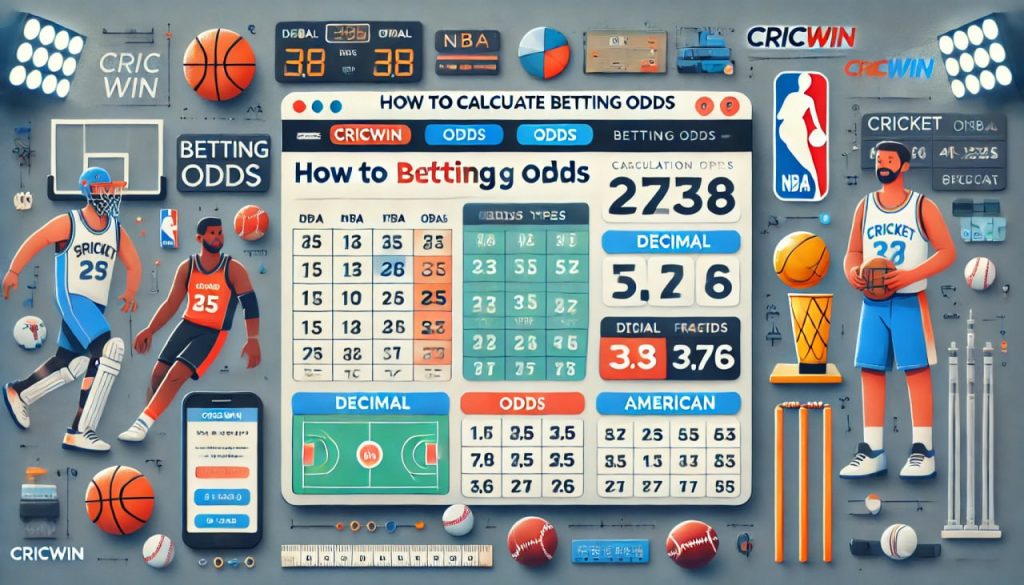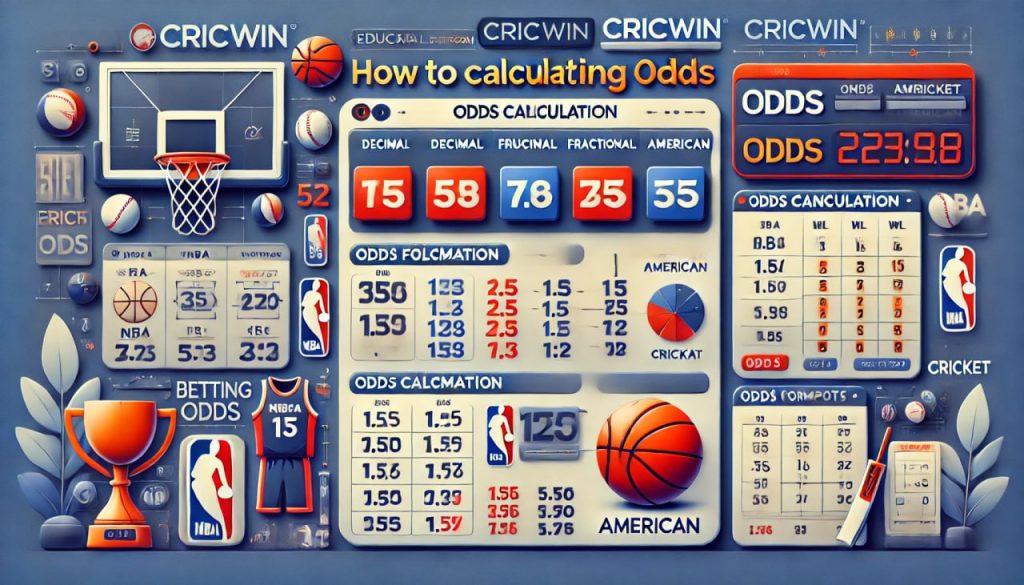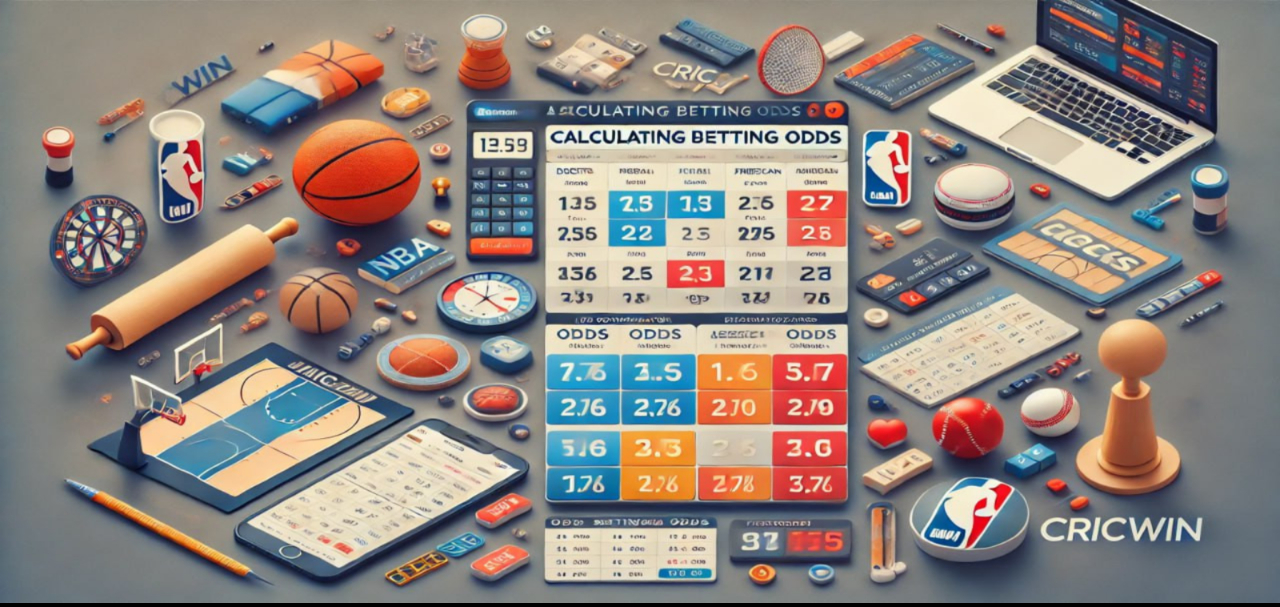Author : Winnie Rogers
Introduction
Betting on sports[1] or events can be thrilling, but to maximize your chances of success, it’s crucial to understand how to calculate betting odds. This comprehensive guide will explore the different types of betting odds, how to convert between them, and the fundamental principles behind odds calculation. By the end, you’ll be equipped with the knowledge needed to make informed betting decisions. Betting odds[2] represent the likelihood of a particular outcome occurring and determine how much you stand to win from a bet. They are expressed in various formats, with the most common being fractional, decimal, and moneyline odds[3].
Types of Betting Odds

- Fractional Odds
- Usage: Primarily used in the UK.
- Format: Represented as a fraction (e.g., 5/1, 10/3).
- Interpretation: The first number indicates your profit for every unit wagered, while the second shows the stake.
- Example: If you bet $10 at 5/1 odds, you would win $50 (5 x $10) plus your original stake, totaling $60.
- Decimal Odds
- Usage: Common in Europe, Canada, and Australia.
- Format: Expressed as a single decimal number (e.g., 6.00, 3.30).
- Interpretation: The number reflects the total return on a $1 stake, including the original stake.
- Example: A $10 bet at 6.00 odds would yield $60 ($10 x 6.00).
- Moneyline Odds
- Usage: Predominantly used in the US.
- Format: Presented as positive or negative numbers (e.g., +500, -200).
- Interpretation: Positive odds indicate how much profit you’d make on a $100 bet, while negative odds[4] show how much you need to wager to make a $100 profit.
- Example: A +500 bet means you would win $500 on a $100 stake, while a -200 bet means you need to stake $200 to win $100.
Calculating Betting Odds
Understanding how to calculate odds is essential for bettors. Here’s a breakdown of how to convert between the different odds formats[5] and how to determine implied probabilities.
Converting Odds Between Formats
Fractional to Decimal
To convert fractional odds to, use the formula:
Decimal Odds=NumeratorDenominator+1\text{Decimal Odds} = \frac{\text{Numerator}}{\text{Denominator}} + 1Decimal Odds=DenominatorNumerator+1
Example: For odds of 5/1:
Decimal Odds=51+1=6.00\text{Decimal Odds} = \frac{5}{1} + 1 = 6.00Decimal Odds=15+1=6.00
Decimal to Fractional
To convert decimal odds to fractional, subtract 1 from the decimal odds and convert to a fraction:
Fractional Odds=Decimal Odds−1\text{Fractional Odds} = \text{Decimal Odds} – 1Fractional Odds=Decimal Odds−1
Example: For odds of 6.00:
Fractional Odds=6.00−1=5/1\text{Fractional Odds} = 6.00 – 1 = 5/1Fractional Odds=6.00−1=5/1
Moneyline to Decimal
- For positive moneyline odds:
Decimal Odds=Moneyline Odds100+1\text{Decimal Odds} = \frac{\text{Moneyline Odds}}{100} + 1Decimal Odds=100Moneyline Odds+1
- For negative moneyline odds:
Decimal Odds=100∣Moneyline Odds∣+1\text{Decimal Odds} = \frac{100}{|\text{Moneyline Odds}|} + 1Decimal Odds=∣Moneyline Odds∣100+1
Examples:
- For +500:
Decimal Odds=500100+1=6.00\text{Decimal Odds} = \frac{500}{100} + 1 = 6.00Decimal Odds=100500+1=6.00
- For -200:
Decimal Odds=100200+1=1.50\text{Decimal Odds} = \frac{100}{200} + 1 = 1.50Decimal Odds=200100+1=1.50
- For decimal odds greater than 2.00 (positive):
Moneyline Odds=(Decimal Odds−1)×100\text{Moneyline Odds} = (\text{Decimal Odds} – 1) \times 100Moneyline Odds=(Decimal Odds−1)×100
- For decimal odds less than 2.00 (negative):
Moneyline Odds=−100Decimal Odds−1\text{Moneyline Odds} = -\frac{100}{\text{Decimal Odds} – 1}Moneyline Odds=−Decimal Odds−1100
Examples:
- For 6.00:
Moneyline Odds=(6.00−1)×100=+500\text{Moneyline Odds} = (6.00 – 1) \times 100 = +500Moneyline Odds=(6.00−1)×100=+500
- For 1.50:
Moneyline Odds=−1001.50−1=−200\text{Moneyline Odds} = -\frac{100}{1.50 – 1} = -200Moneyline Odds=−1.50−1100=−200
Understanding Implied Probability

Implied probability indicates the likelihood of an event happening based on the odds offered. To calculate the implied probability from different odds formats:
From Decimal Odds
Implied Probability=1Decimal Odds×100\text{Implied Probability} = \frac{1}{\text{Decimal Odds}} \times 100Implied Probability=Decimal Odds1×100
Example: For decimal odds of 6.00:
Implied Probability=16.00×100≈16.67%\text{Implied Probability} = \frac{1}{6.00} \times 100 \approx 16.67\%Implied Probability=6.001×100≈16.67%
From Fractional Odds
Implied Probability=DenominatorNumerator+Denominator×100\text{Implied Probability} = \frac{\text{Denominator}}{\text{Numerator} + \text{Denominator}} \times 100Implied Probability=Numerator+DenominatorDenominator×100
Example: For fractional odds of 5/1:
Implied Probability=15+1×100≈16.67%\text{Implied Probability} = \frac{1}{5 + 1} \times 100 \approx 16.67\%Implied Probability=5+11×100≈16.67%
From Moneyline Odds
- For positive moneyline odds:
Implied Probability=100Moneyline Odds+100×100\text{Implied Probability} = \frac{100}{\text{Moneyline Odds} + 100} \times 100Implied Probability=Moneyline Odds+100100×100
- For negative moneyline odds:
Implied Probability=∣Moneyline Odds∣∣Moneyline Odds∣+100×100\text{Implied Probability} = \frac{|\text{Moneyline Odds}|}{|\text{Moneyline Odds}| + 100} \times 100Implied Probability=∣Moneyline Odds∣+100∣Moneyline Odds∣×100
Examples:
- For +500:
Implied Probability=100500+100×100≈16.67%\text{Implied Probability} = \frac{100}{500 + 100} \times 100 \approx 16.67\%Implied Probability=500+100100×100≈16.67%
- For -200:
Implied Probability=200200+100×100≈66.67%\text{Implied Probability} = \frac{200}{200 + 100} \times 100 \approx 66.67\%Implied Probability=200+100200×100≈66.67%
Practical Application of Betting Odds
Understanding and calculating odds isn’t just about knowing how much you can win; it’s also about evaluating the potential risks and making informed betting choices.
Finding Value Bets
Value betting involves identifying situations where the bookmaker’s odds underestimate the probability of an outcome occurring. If you believe an event has a higher likelihood of happening than the odds suggest, it may be a good opportunity to place a bet.
Example of Value Betting
Let’s say you assess a football match and believe a team has a 50% chance to win. If a bookmaker offers odds that imply only a 30% chance, you have a potential value bet. Here’s how to check:
- Bookmaker’s implied probability: If the odds are 3.33 (or 2/1), the implied probability is 13.33×100≈30%\frac{1}{3.33} \times 100 \approx 30\%3.331×100≈30%.
- Your estimation: You believe the true probability is 50%.
Since your probability exceeds that of the bookmaker, betting on this outcome could be profitable in the long run.
Managing Your Bankroll
Proper bankroll management is essential to successful betting. Here are some tips:
- Set a Budget: Decide on a specific amount of money you are willing to bet and stick to it.
- Use a Unit System: Bet a consistent percentage of your bankroll (e.g., 1-5%) on each wager to mitigate risks.
- Track Your Bets: Keep records of your bets to analyze your performance and refine your strategy.
Conclusion
Calculating and understanding betting odds is fundamental to successful betting. By familiarizing yourself with the different formats, learning how to convert between them, and grasping the concept of implied probability, you can make informed and strategic betting decisions. With practice, you’ll enhance your betting skills and hopefully improve your results.
FAQs
What are betting odds?
Betting odds express the likelihood of an event happening and determine how much you can win from your bets. They are presented in fractional, decimal, or moneyline formats.
How do I calculate my potential winnings?
To calculate potential winnings, multiply your stake by the odds (in decimal format) and subtract the stake. For example, with a $10 bet at 5.00 odds: Winnings = ($10 x 5.00) – $10 = $40.
Are higher odds better?
Higher odds typically suggest a less likely event, meaning they offer a higher potential payout. However, they also carry more risk. It’s essential to evaluate whether the odds accurately reflect the true probability.
Can I convert odds formats?
Yes! You can convert between fractional, decimal, and moneyline odds using the formulas provided in this guide.
What is implied probability?
Implied probability indicates the likelihood of an event occurring based on the odds. It helps bettors determine if a bet offers value compared to their own estimation.
